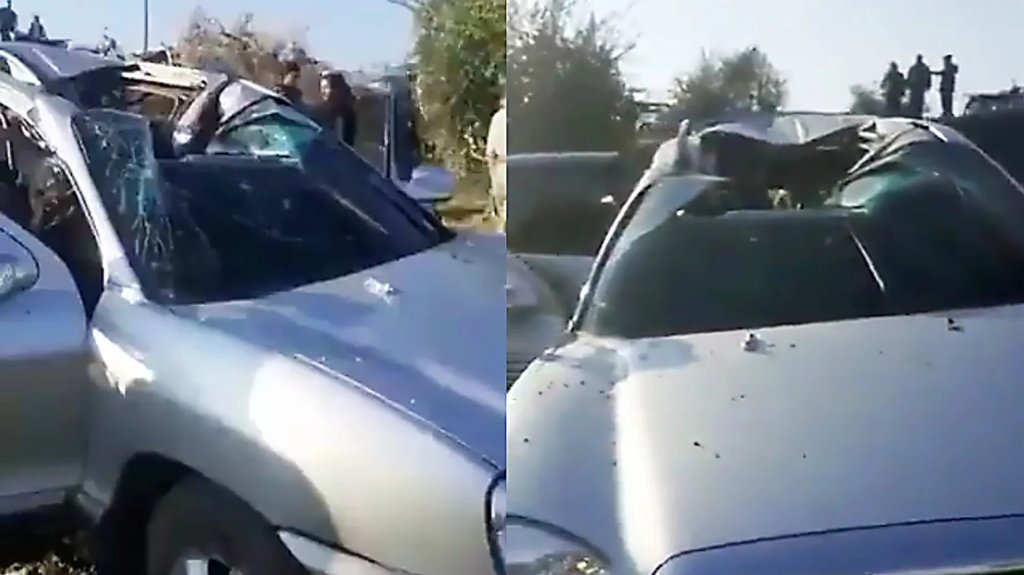Imagery said to show the aftermath of a highly targeted air strike on a car in Lebanon has prompted questions about whether a previously unknown miniature munition designed to produce extremely little collateral damage may have been employed. Damage to the vehicle’s windshield, in particular, has drawn broad comparisons to the telltale impact marks of the AGM-114R9X variant of the Hellfire missile, which has an array of pop-out blades rather than an explosive warhead.
A video and several still pictures from the strike, which is said to have occurred in the Lebanese capital Beirut, began circulation on social media earlier today. The driver was wounded, but it is unclear what their condition might be now. Whether this individual, who does appear to have been identified as of yet, was the intended target of the strike and whether anyone else was in the car at the time is unknown.
This all comes amid a major Israeli campaign targeting the terrorist group Hezbollah characterized so far by unprecedented attacks involving pagers and other electronics rigged to detonate on command, as well as days now of traditional airstrikes. There are now signs Israel may be preparing to invade southern Lebanon.
Warning: some of the images below are very graphic.
Whatever struck the car looks to have hit it from a steep downward angle based on the visible damage to the windshield and the interior, especially the steering wheel, a portion of which is sheered off. The damage also looks to be consistent with a non-explosive kinetic munition designed to destroy its target through force of impact.


The cross-shaped impact mark left in the car’s windshield is a primary factor that has prompted comparisons to the AGM-114R9X, a weapon The War Zone was first to report on the emergence of back in 2017. Also known by the nicknames “ninja bomb” and “the flying Ginsu,” the R9X version of the Hellfire has an array of sword-like blades (likely six) that are designed to pop out right before impact. You can read more about what is known about that missile, which was specifically designed to produce extremely little collateral damage during targeted strikes, here.
It is possible that Israel has developed a miniature aerial munition with four pop-out blades in the same general vein as the AGM-114R9X. At the same time, the potential ‘blades’ are arrayed around a well-defined circular center point. This is very different from what is typically seen after the employment of R9X Hellfires with their long blades explicitly designed to tear through whatever they hit. As such, there is also the possibility the ‘blade’ marks seen on the windshield of the car in Beirut could also be where the fins of a small munition passed through the windshield.

Miniature air-launched munitions of various types, especially to arm equally small drones, are of growing interest globally. There are a number of known designs that feature arrays of stabilizing fins at the tail end or along the body, or both, which could conceivably leave similar impact marks on a car if employed in a non-explosive configuration. Northrop Grumman’s Hatchet, the Shyrke from Corvid Technologies and L3Harris, Raytheon’s Pyros Small Tactical Munition, and Textron’s Fury are examples of such munitions that have been developed just in the United States in recent years. Foreign companies, like Roketsan in Turkey with its MAM family of munitions, are also in this growing market space.


Another possibility might be that the munition that hit the car had an explosive warhead, but it did not detonate for some reason. At the same time, Israel does have an established history of employing aerial munitions with reduced explosive payloads or none at all. The U.S. military and others also employ similar kinds of low-collateral damage munitions, including inert bombs with warhead sections filled with concrete.
The apparent precision of the strike on the car in Beirut also raises the question of how the munition might have been guided. The War Zone has pointed out in the past that the AGM-114R9X could require an operator-in-the-loop guidance system to be able to hit targets, such as a specific individual inside a moving vehicle, very precisely and to do so reliably. Israeli firms have been and continue to be pioneers in the development of operator-in-the-loop guidance capabilities. Advances in artificial intelligence-driven targeting capabilities could drastically help with this, as well. There is even the possibility that the R9X may have some degree of autonomous guidance that can recognize the selected aim point by itself.
Much about the strike on the car in Beirut does remain unknown, but there are certainly signs that point to the employment of a new small and very low collateral damage munition.
It would also make great sense to develop and deploy a smaller ‘Ginsu-like’ munition, especially for use with smaller drones, and for carrying out even more exacting strikes. While what we know about the strike in Beirut does not conclusively prove that such a munition now exists, it may just be a matter of time.
Contact the author: joe@twz.com
